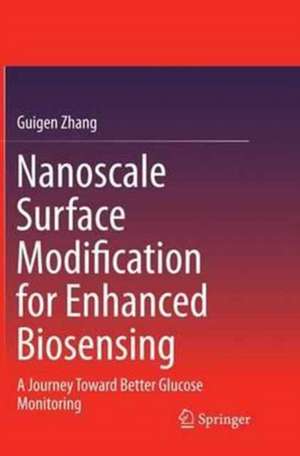Nanoscale Surface Modification for Enhanced Biosensing: A Journey Toward Better Glucose Monitoring
Autor Guigen Zhangen Limba Engleză Paperback – 17 oct 2016
This book also:
· Explains how the performance of an electrochemical-based biosensor can be improved by nanoscale surface modification
· Gives readers the tools to evaluate and improve the performance of a biosensor with a multidisciplinary approach that considers electrical, electrostatic, electrochemical, chemical, and biochemical events
· Links the performance of a sensor to the various governing physical and chemical principles so readers can fully understand how a biosensor with nanoscale modified electrode surface functions.
| Toate formatele și edițiile | Preț | Express |
|---|---|---|
| Paperback (1) | 545.22 lei 38-44 zile | |
| Springer International Publishing – 17 oct 2016 | 545.22 lei 38-44 zile | |
| Hardback (1) | 637.59 lei 6-8 săpt. | |
| Springer International Publishing – 25 iun 2015 | 637.59 lei 6-8 săpt. |
Preț: 545.22 lei
Preț vechi: 681.53 lei
-20% Nou
Puncte Express: 818
Preț estimativ în valută:
104.34€ • 108.27$ • 87.21£
104.34€ • 108.27$ • 87.21£
Carte tipărită la comandă
Livrare economică 11-17 martie
Preluare comenzi: 021 569.72.76
Specificații
ISBN-13: 9783319383231
ISBN-10: 331938323X
Pagini: 111
Ilustrații: XV, 96 p. 55 illus., 20 illus. in color.
Dimensiuni: 155 x 235 mm
Ediția:Softcover reprint of the original 1st ed. 2015
Editura: Springer International Publishing
Colecția Springer
Locul publicării:Cham, Switzerland
ISBN-10: 331938323X
Pagini: 111
Ilustrații: XV, 96 p. 55 illus., 20 illus. in color.
Dimensiuni: 155 x 235 mm
Ediția:Softcover reprint of the original 1st ed. 2015
Editura: Springer International Publishing
Colecția Springer
Locul publicării:Cham, Switzerland
Cuprins
A Brief Overview of Biosensors.- Morphological Surface Modification.- Biochemical Surface Modification.- Adding Nanoparticles in Chemical Modification.- Surface Modified Electrodes in A Microfluidic Biosensor.- Concluding Remarks.
Textul de pe ultima copertă
This book gives a comprehensive overview of electrochemical-based biosensors and their crucial components. Practical examples are given throughout the text to illustrate how the performance of electrochemical-based biosensors can be improved by nanoscale surface modification and how an optimal design can be achieved. All essential aspects of biosensors are considered, including electrode functionalization, efficiency of the mass transport of reactive species, and long term durability and functionality of the sensor.
This book also:
· Explains how the performance of an electrochemical-based biosensor can be improved by nanoscale surface modification
· Gives readers the tools to evaluate and improve the performance of a biosensor with a multidisciplinary approach that considers electrical, electrostatic, electrochemical, chemical, and biochemical events
· Links the performance of a sensor to the various governing physical and chemical principles so readers can fully understand how a biosensor with nanoscale modified electrode surface functions
This book also:
· Explains how the performance of an electrochemical-based biosensor can be improved by nanoscale surface modification
· Gives readers the tools to evaluate and improve the performance of a biosensor with a multidisciplinary approach that considers electrical, electrostatic, electrochemical, chemical, and biochemical events
· Links the performance of a sensor to the various governing physical and chemical principles so readers can fully understand how a biosensor with nanoscale modified electrode surface functions
Caracteristici
Explains how the performance of an electrochemical-based biosensor can be improved by nanoscale surface modification Gives readers the tools to evaluate and improve the performance of a biosensor with a multidisciplinary approach that considers electrical, electrostatic, electrochemical, chemical, and biochemical events Links the performance of a sensor to the various governing physical and chemical principles so readers can fully understand how a biosensor with nanoscale modified electrode surface functions













